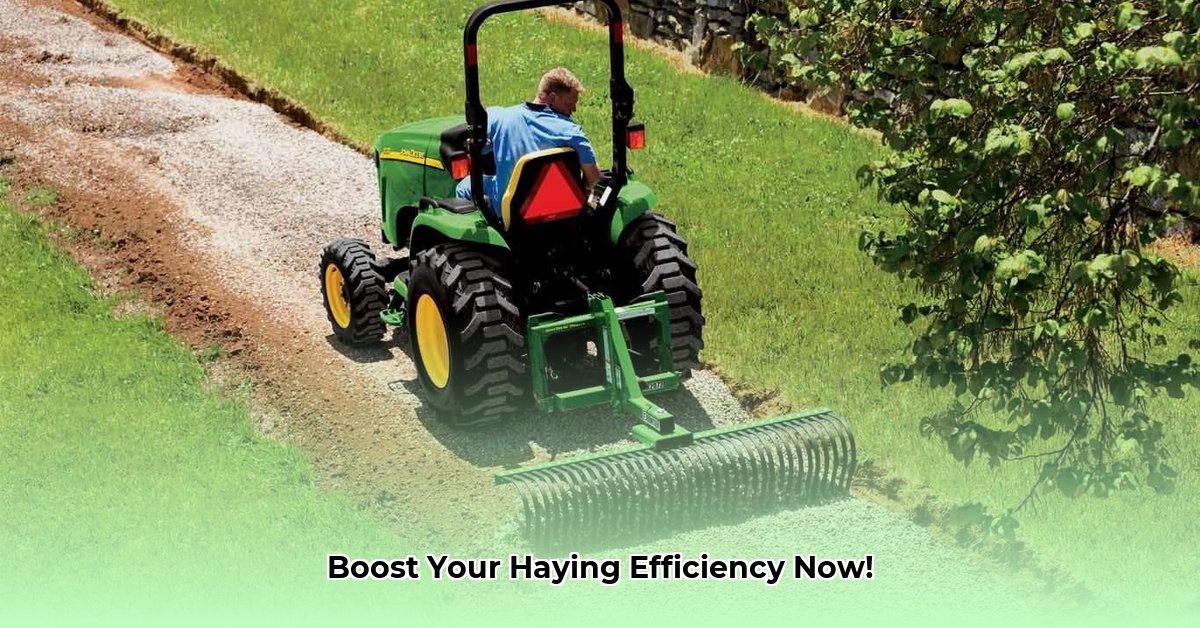
Rakes for Tractors: Optimizing Farm Efficiency
Choosing the right tractor rake significantly impacts operational efficiency and profitability. This article analyzes Everything Attachments (EA) landscape rakes, comparing their strengths and weaknesses to inform your purchasing decision. We'll cover practical considerations, including cost analysis, durability assessment, and strategies for mitigating shipping delays. For more information on choosing the right rake, check out this helpful guide: tractor rake guide.
Everything Attachments' Landscape Rakes: A Comprehensive Review
EA rakes, manufactured in the USA, are praised for their robust construction and ability to handle demanding tasks like brush clearing and field leveling. The "floating top link" design (a system allowing the rake to adapt to uneven terrain) and precise gauge wheels (wheels ensuring consistent grading depth) are frequently highlighted as key advantages. Farmers report successful use in diverse applications, from driveway grading to snow removal.
However, substantial shipping delays—often exceeding five months—represent a major drawback. Reports of bent gauge wheel brackets point to potential packaging or handling issues, leading to costly repairs and downtime. This underscores the importance of considering total cost of ownership, encompassing initial purchase price, potential repairs, and lost productivity.
Comparing Tractor Rakes: Beyond the Price Tag
While EA rakes command a higher price due to their American manufacturing and durable construction, the long-term cost-effectiveness needs careful evaluation. A cheaper alternative might necessitate more frequent repairs and extended downtime, ultimately negating initial savings. A thorough cost-benefit analysis, factoring in repair expenses and productivity losses, is crucial. Do you prioritize durability, or does minimizing up-front costs outweigh potential future expenses?
Five Steps to Selecting the Ideal Tractor Rake
- Define Your Needs: Assess your primary applications (e.g., brush clearing, leveling), typical terrain, and budget constraints. What are your priorities?
- Conduct a Detailed Comparison: Compare EA specifications (tine material, weight, dimensions) with competing brands to ensure an objective assessment. Look to find details not readily available on EA's site from other manufacturer's details and independent reviews.
- Account for Shipping Delays: Factor in potential delays of several months when planning your purchase to avoid disruptions.
- Analyze User Reviews Critically: Examine both positive and negative reviews, identifying recurring issues to gain a more accurate understanding of potential problems.
- Evaluate Warranty Coverage: A robust warranty demonstrates manufacturer confidence and can mitigate long-term risks.
Areas for Improvement in Everything Attachments' Offerings
EA could significantly enhance customer satisfaction by addressing the persistent shipping delays. Investing in supply chain optimization and increased production capacity would mitigate this critical issue. Improved packaging could prevent damage during shipping, further reducing repair costs and downtime for customers. Furthermore, more comprehensive product specifications would facilitate easier comparisons with competitor products.
Mitigating Shipping Delays for Heavy-Duty Landscape Rakes
Proactive planning is essential to mitigate delays. Order well in advance of your project timeline to accommodate potential shipping delays. Consider selecting a supplier with a proven track record of on-time delivery and excellent customer service. Exploring local distributors may also provide faster delivery options and reduce transportation costs.
Weighing the Costs: DIY vs. Commercial Rakes
Constructing a DIY rake can offer substantial cost savings (up to 70-80%), but requires significant welding and metalworking skills, along with readily available materials. Commercial rakes, while more expensive upfront, generally provide superior durability, warranties, and easier access to support and replacement parts. A DIY approach might save money but could cost significantly more in the long run if the rake isn't built correctly or fails prematurely.
Optimizing Rake Efficiency: Gauge Wheels and Tine Design
Gauge wheels maintain consistent grading depth, streamlining operation and improving the quality of work. Appropriate tine spacing (often suggested at 1 3/4 inches) is crucial for efficient debris collection, although optimal spacing depends on the material being raked. Consider whether pivoting or fixed tines better suit your needs.
The Bottom Line: Making an Informed Decision
Selecting a tractor rake requires careful consideration of various factors. EA rakes offer robust construction and longevity, but prolonged shipping delays pose a significant challenge. Thorough research, comparative analysis, and a clear understanding of your needs will guide you towards the most cost-effective and efficient solution for your specific agricultural or landscaping operation. Remember that the "best" rake is highly dependent on individual needs and circumstances.